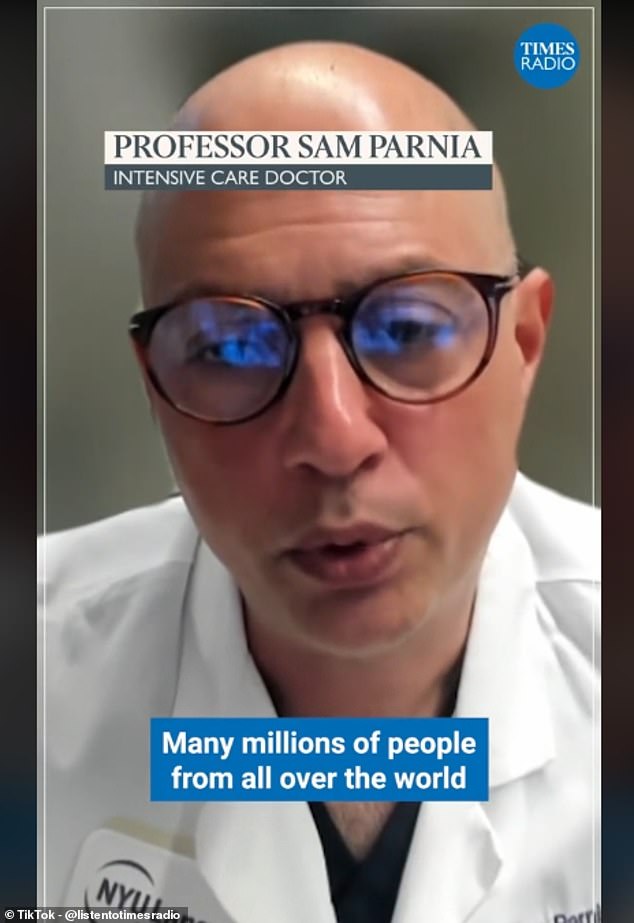A top US scientist claims to have discovered evidence of an afterlife, thanks to studies involving millions of patients who’ve had near-death experiences.
According to Dr Sam Parnia, an associate professor of medicine at New York University’s Langone Medical Center, patients who are resuscitated after their heart stops frequently recount re-living ‘every single moment of their lives’.
Particularly remarkable, he claims, is that they relive memories not only from their own perspective, but as if they’re looking through other people’s eyes.
These phenomena, which have been a source of fascination for medics and the public alike for decades, are believed to occur when people are clinically ‘dead’, and extremely unlikely to survive.
Dr Parnia has undertaken 30 years of research involving millions of people to assess where life ends and death begins.
He told Times Radio: ‘Many millions of people all over the world have gone through this early phase of death and been brought back to life again.
‘We’ve studied this in many thousands of people using many different scientific methods.

According to Dr Sam Parnia, an associate professor of medicine at New York University’s Langone Medical Center, patients frequently ‘start to relive every single moment of their lives’

Yet ‘what is really remarkable’ in this state, he claims, is that they relive them ‘not only from their own perspective but from the other person’s experience’ too
‘Incredibly, [patients] consistently report that even though from the outside perspective there looks like there is no consciousness and they’re supposed to be dead, internally they go through a new experience.
‘They feel that their own consciousness, their selfhood, becomes suddenly vast and it becomes more lucid and more sharp.
‘They are able to gather information about what’s happening to them as doctors and nurses are trying to revive them.
‘They gather this information almost in 360 degrees and they come to recognise that “it looks like I’m dead”.’
He added: ‘What’s really remarkable is that in this state, they then start to relive every single moment of their lives, every interaction they’ve had with others — not only from their own perspective but also the other person’s experience and perspective.
‘For example, if they had done something to hurt someone, they relive the exact same pain the other person has had.
‘If they’ve done something that’s caused happiness in other people, they relive the same happiness.’
Experiences of seeing and hearing things whilst clinically dead do have some scientific basis.

Amber Cavanagh previously told MailOnline she was 43 when she suffered two strokes and entered the ‘meeting point’ of heaven

Mrs Cavanagh, from Canada, said she could see her husband (pictured above) ‘weeping over’ her body
For years studies have shown the human brain still functions normally for a very brief time after the heart stops, although it appears to have ceased activity on regular scans.
Research has also revealed that the brain can still experience sporadic bursts of activity even after an hour without oxygen, during resuscitation.
Such discoveries have led to some medics calling for an overhaul of the standard practice that rules people should be declared dead after three-to-five minutes of oxygen deprivation to the brain, as these patients could still in theory be resuscitated.
Dr Parnia added: ‘Nothing about this is what we expected it to be. We weren’t supposed to be able to reverse death.
‘We weren’t supposed to investigate what happens beyond death.
‘You and I can’t remember more than a fraction of our lives now if they asked us to.
But yet, in death, it’s as if everything was recorded in life that comes to the fore like an iceberg that emerges.

While evidence on something happening in brains after clinical death is still being explored, exactly why so many people have similar experiences remains an issue of contention among experts
‘You’re suddenly evaluating your entire life based upon a prism of morality and ethics.’
He also said: ‘Of course, many of these people don’t come back.
‘But when they do, they’re positively transformed because they recognise that there has been a deeper purpose to life and that even the smallest actions and the smallest thoughts — as hidden as they may have been — were not really hidden.’
People have previously told MailOnline of out of body experiences such as seeing bright lights at the end of a tunnel or meeting deceased relatives.
Others, meanwhile, have also recalled seeing a heavenly afterlife.
While evidence on something happening in brains after clinical death is still being explored, exactly why so many people have similar experiences remains an issue of contention among experts.
Some theorise that as the brain is undergoing these changes essentially the ‘brakes’ come off the system and this opens our perception to incredibly lucid and vivid experiences of stored memories from our lives.
However, this is only a theory and other experts dispute this.
Clinical death also differs from brain death.
Brain death is when a person on an artificial life support machine no longer has any brain function, which means they will not regain consciousness.
Such patients have no chance of recovery because their body is unable to survive without artificial life support.
In the UK this means a person who has suffered brain death is legally dead.
This can be difficult to comprehend for families of the deceased as they can see their loved one’s chest rise and fall with every breath from the ventilator as well as their heart continuing to beat.
Brain death can be caused by both illness and injury when blood and/or oxygen supplies are cut off to the vital organ.
The condition is different from a vegetative state where a patient’s brain function remains.
This article was originally published by a www.dailymail.co.uk . Read the Original article here. .


